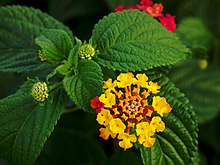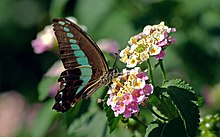കൊങ്ങിണി
| Lantana camara[1] | |
|---|---|

| |
| Flowers and leaves | |
| ശാസ്ത്രീയ വർഗ്ഗീകരണം | |
| കിങ്ഡം: | സസ്യലോകം |
| ക്ലാഡ്: | ട്രക്കിയോഫൈറ്റ് |
| ക്ലാഡ്: | സപുഷ്പി |
| ക്ലാഡ്: | യൂഡികോട്സ് |
| ക്ലാഡ്: | Asterids |
| Order: | Lamiales |
| Family: | Verbenaceae |
| Genus: | Lantana |
| Species: | L. camara
|
| Binomial name | |
| Lantana camara | |
| പ്രമാണം:Global distribution of Lantana camara.svg | |
| Global distribution of Lantana camara | |
| Synonyms | |
വെർബനേസി സസ്യകുടുംബത്തിലെ ഒരു സപുഷ്പിസസ്യമാണ് അരിപ്പൂച്ചെടി.(ശാസ്ത്രീയ നാമം:Lantana camara) ഇത് അമേരിക്കയിലെ ഉഷ്ണമേഖലാപ്രദേശങ്ങളിലെ സ്വദേശിയാണ്.[4][5]
പൂന്തോട്ടങ്ങളെ മോടിപിടിപ്പിക്കാൻ വെച്ചുപിടിപ്പിക്കുന്ന ഈ ചെടി അതിന്റെ സ്വദേശത്തുനിന്ന് ലോകമെമ്പാടും 60ഓളം രാജ്യങ്ങളിലേക്ക് പരക്കുകയും,[6] അധിനിവേശ സ്പീഷീസായി മാറുകയും ചെയ്തിട്ടുണ്ട്.[7] ഡച്ചുകാർ അമേരിക്കയിൽ നിന്ന് ഇതിനെ യൂറോപ്പിലേക്ക് കൊണ്ടുവന്ന് നട്ടുവളർത്തുകയും ഏഷ്യയിലേക്കും ഓഷ്യാനിയയിലേക്കും എത്തിക്കുകയും ചെയ്തു. ഇവിടങ്ങളിൽ ഈ ചെടി പ്രാദേശിക പരിസ്ഥിതിക്ക് അപകടകരമായ വിധത്തിൽ പടർന്നുപിടിക്കുകയും ചെയ്തു.
ജൈവവൈവിധ്യം കുറയ്ക്കുന്ന തരത്തിൽ അഭിലഷണീയമായ സ്പീഷീസുകളെ മത്സരിച്ച് തോൽപ്പിക്കാൻ അരിപ്പൂച്ചെടിക്ക് കഴിയും.[8] ഇത് കാർഷിക മേഖലയിൽ കടന്നുകൂടുമ്പോൾ കന്നുകാലികൾക്ക് വിഷബാധയേൽക്കാൻ സാദ്ധ്യതയുള്ളത് കൊണ്ടും ഇടതൂർന്ന് വളരുന്നതുകൊണ്ടും കൃഷിഭൂമിയുടെ ഉല്പാദനക്ഷമത കുറയ്ക്കുന്നു.[9]
വിവരണം
[തിരുത്തുക]

Lantana camara is a 2 മീറ്റർ വരെ ഉയരത്തിൽ വളരുന്ന ബഹുവർഷി സസ്യമാണ് അരിപ്പൂച്ചെടി, കൊങ്ങിണിപ്പൂവ് എന്നൊക്കെ അറിയപ്പെടുന്ന Lantana camara.[10] 17-18 നൂറ്റാണ്ടുകളിൽ വ്യാപകമായി തെരഞ്ഞെടുത്ത് പ്രജനനം(selective breeding) നടത്തിയിരുന്നത് മൂലം ഒട്ടേറെ വ്യത്യസ്ത ഇനം ചെടികൾ ഈ സ്പീഷീസിൽ ഉണ്ട്.
Lantana camara നാലിതളുള്ള അനേകം പൂവുകൾ ഒരുമിച്ച് ചേർന്നതാണ് ഇതിന്റെ പൂവ്. ചുവപ്പ് മഞ്ഞ, വെള്ള, പിങ്ക്, ഓറഞ്ച് എന്നിങ്ങനെ പലനിറത്തിൽ പൂക്കൾ കാണാം. ഇതിൽ തന്നെ പൂങ്കുലയിലെ സ്ഥാനവും, പ്രായവും, മൂപ്പും അനുസരിച്ച് നിറഭേദം ഉണ്ടാകുന്നു.[11] പരാഗണത്തിനു ശേഷം പൂക്കളുടെ നിറം മാറുന്നു. ഇത് മെച്ചപ്പെട്ട പരാഗണസാദ്ധ്യതയ്ക്കായി പരാഗണകാരികൾക്കുള്ള സൂചനയായി കണക്കാക്കപ്പെടുന്നു.[12]
ലഘുപത്രങ്ങൾ സമ്മുഖമായി വിന്യസിച്ചിരിക്കുന്നു. ഇലകൾ ഞെരിക്കുമ്പോൾ ശക്തമായ ഒരു ഗന്ധം പുറപ്പെടുവിക്കുന്നു.[13]

ഉരുണ്ട ഫലങ്ങൾ മൂപ്പെത്തുമ്പോൾ പച്ചയിൽ നിന്ന് കടും പർപ്പിൾ നിറമാകുന്നു. കായികപ്രജനനവും ലൈംഗികപ്രജനവും നടക്കുന്നു.[14] പാകമായ കായകൾ കിളികളും മറ്റു ജീവികളും ഭക്ഷിക്കുകയും ദൂരപ്രദേശങ്ങളിൽ എത്തിച്ച് വ്യാപനത്തിന് സഹായിക്കുകയും ചെയ്യുന്നു.
വിതരണം
[തിരുത്തുക]
ഇതിന്റെ സ്വദേശം മദ്ധ്യ അമേരിക്കയും തെക്കേ അമേരിക്കയും ആണെങ്കിലും ഇന്ന് ഇത് 60 ഓളം ഉഷ്ണമേഖലാ രാജ്യങ്ങളിലും മിതോഷ്ണ രാജ്യങ്ങളിലും സ്വാഭാവികമായി വളരുന്നു.[15][16] ആഫ്രിക്കയിലെ തെക്കു കിഴക്കൻ പ്രദേശങ്ങളിൽ കൃഷിക്കായി വനം വെട്ടിനീക്കിയ പ്രദേശങ്ങളിൽ വളരുന്നു.[17]
സ്പെയിൻ, പോർച്ചുഗൽ, പശ്ചിമേഷ്യൻ രാജ്യങ്ങൾ, ഇന്ത്യ, ഏഷ്യയുടെ ഉഷ്ണമേഖലാ പ്രദേശങ്ങൾ, ഓസ്ട്രേലിയ, ന്യൂസിലാൻഡ്, അമേരിക്ക തുടങ്ങിയ രാജ്യങ്ങളിലും അരിപ്പൂച്ചെടി വളരുന്നു.[18][19] റോയൽ ബൊട്ടാണിക്കൽ ഗാർഡൻ ഓഫ് ശ്രീലങ്കയിൽ (Royal Botanic gardens of Sri Lanka) വളർന്നിരുന്ന ഈ ചെടി 1926ൽ പുറത്തേക്ക് പരക്കുകയും ഇന്ന് വ്യാപകമായി കളയായി വളരുകയും ചെയ്യുന്നു.[20][21]
പരിസ്ഥിതി
[തിരുത്തുക]ആവാസസ്ഥാനം
[തിരുത്തുക]
അരിപ്പൂച്ചെടി വിവിധ പരിസരങ്ങളിൽ വളരുന്നു:
- കൃഷിഭൂമി
- കാടിന്റെ അതിർത്തികളും വിടവുകളും
- നദിക്കരയിലെ ആവാസവ്യവസ്ഥ
- പുൽമേടുകൾ
- ദ്വിതീയവനങ്ങൾ
- കടലോരങ്ങൾ
വലിയ വൃക്ഷങ്ങളുമായി വെളിച്ചത്തിനായുള്ള മത്സരത്തിൽ ജയിക്കാൻ പ്രയാസമായതിനാൽ സ്വാഭാവികവനങ്ങളിൽ അരിപ്പൂച്ചെടി അപൂർവമായേ കാണുകയുള്ളു. ഇവ കാടിന്റെ അതിരുകളിൽ നന്നായി വളരുന്നു. വരൾച്ച, വിവിധ മണ്ണിനങ്ങൾ, ചൂട്, ഈർപ്പം, ഉപ്പിന്റെ അംശം എന്നിങ്ങനെ ഒട്ടേറെ തീവ്രമായ കാലാവസ്ഥാ ഭേദങ്ങളെ അതിജീവിക്കാൻ അരിപ്പൂച്ചെടിക്ക് കഴിയും. തീയെ താരതമ്യേന ഫലപ്രദമായി പ്രതിരോധിക്കുകയും കത്തിപ്പോയ കാടിന്റെ ഭാഗങ്ങളിൽ നിന്ന് വളരെപ്പെട്ടെന്ന് വളർന്നു വരികയും ചെയ്യും.[22]
ജൈവാധിനിവേശം
[തിരുത്തുക]ആഫ്രിക്ക, ഏഷ്യ, ആസ്ത്രേലിയ, ന്യൂസീലാൻഡ്(പാലിയോട്രോപ്പിക്കൽ പ്രദേശങ്ങൾ) അരിപ്പൂച്ചെടി കളയായി കണക്കാക്കപ്പെടുന്നു. ദ്വിതീയ വനപ്രദേശങ്ങളിലും കാർഷിക മേഖലകളിലും ഇവ വളരെപ്പെട്ടെന്ന് അടിക്കാട്ടിലെ കുറ്റിച്ചെടികൾക്കിടയി ആധിപത്യം സ്ഥാപിക്കുന്നു. ജൈവവൈവിദ്ധ്യം കുറയ്ക്കുന്ന തരത്തിൽ പ്രാദേശിക സ്പീഷീസുകൾ കുറയാൻ ഇത് കാരണമാകുന്നു.
അരിപ്പൂച്ചെടി സ്വയം തീയെ പ്രതിരോധിക്കാൻ കഴിയുന്നതാണെങ്കിലും തീകത്താനുള്ള ഇന്ധനമായി മാറി മരമേലാപ്പിലേക്ക് തീ പടരാനുള്ള കാരണമാകുന്നു.[23] ഇത് വരണ്ട പ്രദേശങ്ങളിൽ സ്വാഭാവിക ആവാസവ്യവസ്ഥയുടെ നാശത്തിന് കാരണമാകുന്നു.
ഇടതൂർന്ന് വളർന്ന് കൃഷിയിടങ്ങളിൽ ഉല്പാദനം കുറയ്ക്കുകയും വിളവെടുപ്പ് ദുഷ്കരമാക്കുകയും ചെയ്യുന്നു. ആഫ്രിക്കയിൽ മലേറിയ പോലുള്ള രോഗങ്ങൾ പടർത്തുന്ന കൊതുകുകൾ ഈ ചെടിയുടെ ഇടയിൽ അഭയം തേടുന്നതുകൊണ്ട് പരോക്ഷമായും ഇത് മനുഷ്യരെ പ്രതികൂലമായി ബാധിക്കുന്നു.[24]
പശ്ചിമഘട്ടത്തിൽ ഇത് അധിനിവേശ സസ്യമാണെങ്കിലും പ്രദേശത്തിന്റെ ജൈവ വൈവിദ്ധ്യത്തിൽ വലിയ ആഘാതം ഉണ്ടാക്കിയതായി കാണുന്നില്ല. ഈർപ്പമുള്ള ചിലപ്രദേശങ്ങളിൽ മറ്റ് സ്പീഷീസുകളെ പോലെ വളരുന്നു എന്നു മാത്രം.[25]
അരിപ്പൂച്ചെടി അധിനിവേശസസ്യമെന്ന നിലയിൽ ഫലപ്രദമായി പടർന്നു പിടിക്കാനുള്ള ഒട്ടേറെ കാരണങ്ങളുണ്ട്. എങ്കിലും പ്രാഥമിക കാരണങ്ങൾ ഇവയാണ്:
- പക്ഷികളും മറ്റ് ജന്തുക്കളും വഴിയുള്ള വിത്ത് വിതരണം
- വിഷാംശമുള്ളതിനാൽ മൃഗങ്ങൾ തിന്നു നശിപ്പിക്കാനുള്ള സാദ്ധ്യത കുറവ്
- മിക്കവാറും കാലാവസ്ഥകളോട് സഹിഷ്ണുത കാട്ടുന്നു
- പരിസ്ഥിതിയിൽ അരിപ്പൂച്ചെടിക്ക് അനുകൂലമായ മാറ്റങ്ങൾ
- വളർച്ചയിൽ മത്സരിക്കുന്ന മറ്റ് സസ്യസ്പീഷീസുകൾക്ക് വിഷമയമായ രാസവസ്തുക്കൾ ഉല്പാദിപ്പിക്കുന്നു
- വളരെ വലിയ അളവിൽ വിത്തുകൾ ഉല്പാദിപ്പിക്കുന്നു(ഒരു ചെടിയിൽ നിന്ന് ഒരു വർഷം 12000 വിത്തുകൾ വരെ ഉണ്ടാകും)[26]
വിഷാംശം
[തിരുത്തുക]
കന്നുകാലികൾ, ചെമ്മരിയാട്, കുതിര, നായ, ആടുകൾ എന്നിവയ്ക്ക് അരിപ്പൂച്ചെടി വിഷമാണ്.[27][28] മൃഗങ്ങൾക്ക് വിഷമയമാകുന്നത് പ്രകാശ അതിസംവേദനവും കരൾ തകരാറുകളും ഉണ്ടാക്കുന്ന പെന്റാസൈക്ലിക് ട്രൈറ്റെർപനോയിഡുകളാണ്T(pentacyclic triterpenoids).[29] L. camara മറ്റ് സ്പീഷീസുകളുടെ വിത്തു മുളയ്ക്കുന്നതും വേരു വളരുന്നതും തടയുന്ന രാസവസ്തുക്കളും അരിപ്പൂച്ചെടി പുറത്തു വിടുന്നുണ്ട്(അലേലോപ്പതി-allelopathy).[30]
മനുഷ്യരിൽ ഇതിന്റെ വിഷപ്രഭാവം കൃത്യമായി നിർണയിക്കപ്പെട്ടിട്ടില്ല. മൂപ്പെത്താത്ത കായകൾ ഭക്ഷിക്കുന്നത് വിഷബാധയുണ്ടാക്കും എന്ന് കാണിക്കുന്ന പഠനങ്ങൾ ഉണ്ട്.[31] എന്നാൽ പാകമായ കായകൾ കഴിക്കുന്നത് മനുഷ്യർക്ക് പ്രശ്നമൊന്നും ഉണ്ടാക്കുന്നില്ല.[32][33]
പരിപാലനവും നിയന്ത്രണവും
[തിരുത്തുക]
ആവാസവ്യവസ്ഥയുടെ ആരോഗ്യം നിലനിർത്തുന്നതാണ് അരിപ്പൂച്ചെടിയുടെ വ്യാപനം നിയന്ത്രിക്കാൻ ഏറ്റവും ഫലപ്രദമായ മാർഗം.
ജൈവമാർഗങ്ങൾ
[തിരുത്തുക]കീടങ്ങളും ജൈവ നിയന്ത്രണ മാർഗങ്ങളും അരിപ്പൂച്ചെടിയുടെ വ്യാപനം നിയന്ത്രിക്കാൻ ഉപയോഗിക്കുന്നുണ്ട്. ജൈവ നിയന്ത്രണമാർഗങ്ങൾ ഉപയോഗിച്ച് വ്യാപനം തടയാൻ ശ്രമിച്ച ആദ്യത്തെ കള അരിപ്പൂച്ചെടിയാണെങ്കിലും 33 മേഖലകളിൽ 36 വ്യത്യസ്ത നിയന്ത്രണോപാധികൾ പരീക്ഷിച്ചെങ്കിലും ഒന്നും വിജയകരമായില്ല.[34]
അരിപ്പൂച്ചെടിയുടെ സങ്കരയിനങ്ങളുടെ ആധിക്യവും വലിയ ജനിതകവൈവിധ്യവുമാവണം ജൈവ മാർഗങ്ങൾ വിജയകരമാവാതിരിക്കാനുള്ള കാരണം. ടിപ്പിഡ് ബഗ്ഗുകളെ ഉപയോഗിച്ച് ഇന്ത്യയിൽ ഗവേഷണം നടത്തിയ ഒരു നിയന്ത്രണ മാർഗം ചില ഉപയോഗപ്രദമായ ഫലങ്ങളിൽ എത്തിയിട്ടുണ്ട്.[35]
യാന്ത്രികം
[തിരുത്തുക]കളകളെ നീക്കം ചെയ്യുക എന്നതാണ് ഈ മാർഗം. ഇത് വലിയ ചെലവു വരുന്നതാണ്. ചെറിയ പ്രദേശങ്ങളിൽ ഇത് പ്രായോഗികമാക്കാം. തീ ഉപയോഗിച്ച് അരിപ്പൂച്ചെടി നശിപ്പിച്ചശേഷം പ്രാദേശിക സസ്യജനുസ്സുകളെ നട്ടുപിടിപ്പിച്ചുകൊണ്ട് പുനർജീവനം തടയുന്നത് മറ്റൊരു മാർഗ്ഗമാണ്.
രാസപ്രയോഗം
[തിരുത്തുക]കളനാശിനികൾ ഉപയോഗിച്ചുള്ള നിയന്ത്രണം ചെലവേറിയതും ഫലപ്രദവുമാണ്. ചെടി മുറിച്ച് നശിപ്പിച്ചശേഷം കളനാശിനി പ്രയോഗിക്കുന്നത് ഗുരുതരമായ പരിസ്ഥിതി പ്രശ്നങ്ങൾ ഉണ്ടാക്കുന്നതും ഫലപ്രദവുമായ രീതിയാണ്.
ഉപയോഗങ്ങൾ
[തിരുത്തുക]
കസേരകളും മേശകളും ഉണ്ടാക്കാൻ അരിപ്പൂച്ചെടിയുടെ തണ്ടുകൾ ഉപയോഗിക്കാം.[36] എന്നാൽ പണ്ടുമുതൽ ഇതിന്റെ പ്രധാന ഉപയോഗം അലങ്കാരമായും മരുന്നായും ആണ്.
ഔഷധഗുണം
[തിരുത്തുക]രോഗാണു നാശകവും, കുമിൾനാശകവും, കീടനാശകവുമായ ഗുണങ്ങൾ അരിപ്പൂച്ചെടിക്ക് ഉള്ളതായി ഇന്ത്യയിൽ നടന്ന പഠനങ്ങൾ കണ്ടെത്തിയിട്ടുണ്ട്.[37] പാരമ്പര്യ ചികിത്സയിൽ കാൻസർ, ത്വഗ്രോഗങ്ങൾ, കുഷ്ഠം, പേവിഷബാധ, ചിക്കൻപോക്സ്, മീസിൽസ്, ആസ്ത്മ, അൾസർ എന്നിവ ചികിത്സിക്കാൻ ഇത് ഉപയോഗിക്കുന്നു.
അലങ്കാരം
[തിരുത്തുക]പൂന്തോട്ടങ്ങളിൽ അലങ്കാരമായി ഇത് ഉപയോഗിക്കുന്നു.വെള്ളം ഇല്ലാതെ കൂടുതൽ കാലം നിലനിൽക്കാനുള്ള കഴിവും, കീടബാധ ഇല്ല എന്നതും ഇതിനെ ജനപ്രിയമാക്കി. . ഇത് പൂമ്പാറ്റകളെ ആകർഷിക്കുന്നതിനാൽ ഫ്ലോറിഡയിലെ ബട്ടർഫ്ലൈ ഗാർഡനുകളിൽ ഉപയോഗിക്കപ്പെടുന്നു.
ആതിഥേയ സസ്യം
[തിരുത്തുക]അരിപ്പൂച്ചെടിയുടെ പൂവ് ഒട്ടേറെ പൂമ്പാറ്റ സ്പീഷീസുകൾക്ക് ഭക്ഷണമൊരുക്കുന്നു. പടിഞ്ഞാറേ അർദ്ധഗോളത്തിലെ ഏറ്റവും വലിയ പൂമ്പാറ്റയായ പാപ്പിലിയോ ഹോമെറസ്(Papilio homerus) ഇതിന്റെ തേൻ കുടിക്കുന്നതായി കണ്ടിട്ടുണ്ട്.[38]
നിരുക്തി
[തിരുത്തുക]ലന്റാന എന്ന വാക്ക് Viburnum lantana(wayfaring tree), എന്ന ചെടിയുടെ പൂക്കളുമായി നല്ല സാമ്യമുള്ളതിനാൽ അതിന്റെ ലാറ്റിൻ നാമത്തിൽ നിന്ന് ഉല്ഭവിച്ചതാണ്.[39][40]

കമാനാകൃതിയിലുള്ളത് എന്നർത്ഥം വരുന്ന ഗ്രീക്ക് പദത്തിൽ നിന്നാണ് Camara എന്ന പദം ഉൽഭവിച്ചത്.

ചിത്രശാല
[തിരുത്തുക]അവലംബം
[തിരുത്തുക]- ↑ Munir A (1996). "A taxonomic review of Lantana camara L. and L. montevidensis (Spreng.) Briq. (Verbenaceae) in Australia". Journal of the Adelaide Botanic Gardens. 17: 1–27.
- ↑ [ Lantana camara.]|url=http://www.ars-grin.gov/~sbmljw/cgi-bin/taxon.pl?310628 Germplasm Resources Information Network (GRIN).
- ↑ "Global Invasive Species Database". issg.org.uk. Archived from the original on 2014-04-07. Retrieved 2014-03-22.
- ↑ Floridata LC (2007). "Lantana camara". Floridata LC. Retrieved March 24, 2014.
- ↑ Moyhill Publishing (2007). "English vs. Latin Names". Moyhill Publishing. Retrieved March 24, 2014.
- ↑ Day, M. D. (December 24, 2003). Lantana: current management status and future prospects. Australian Centre for International Agricultural Research. ISBN 1863203753. Retrieved March 24, 2014.
- ↑ Sharma, OM.P.; Harinder, Paul S (1988). "A review of the noxious plant Lantana camara". Toxicon. 26 (11): 975–987. doi:10.1016/0041-0101(88)90196-1. Retrieved 24 March 2014.
- ↑ Kohli, Ravinder. K. (2006). "Status, invasiveness and environmental threats of three tropical American invasive weeds (Parthenium hysterophorus L., Ageratum conyzoides L., Lantana camara L.) in India". Biological Invasions. Biological Invasions. 8 (7): 1501–1510. doi:10.1007/s10530-005-5842-1. Retrieved March 25, 2014.
- ↑ Ensbey, Rob. "Lantana - Weed of National Significance".
- ↑ Sharma, O.P. (1981). "A Review of the Toxicity of Lantana camara (Linn) in Animals". Clinical Toxicology. 18 (9): 1077–1094. doi:10.3109/15563658108990337.
- ↑ MOHAN RAM, H.Y. (1984). "Flower Colour Changes in Lantana camara". Journal of Experimental Botany. 35 (11): 1656–1662. doi:10.1093/jxb/35.11.1656.
- ↑ Weiss, Martha. R. (1990). "FLORAL COLOR CHANGES AS CUES FOR POLLINATORS".
{{cite journal}}: Cite journal requires|journal=(help) - ↑ Rosacia, W. Z.; et al. (2004). "Lantana and Hagonoy: Poisonous weeds prominent in rangeland and grassland areas" (PDF). Research Information Series on Ecosystems. Department of the Environment and Natural Resources, Republic of the Philippines. 16 (2). Archived from the original (PDF) on 2012-03-23. Retrieved July 27, 2011.
- ↑ "Lantana camara". 2008. Archived from the original on 2015-07-30. Retrieved 2018-05-21.
- ↑ Florida Exotic Pest Plant Council (2005). "Florida Exotic Pest Plant Council: Lantana camanara" (PDF). Florida Exotic Pest Plant Council. Archived from the original (PDF) on 2018-05-17. Retrieved 2018-05-21.
- ↑ Sanders, R.W. (2012). "Taxonomy of Lantana sect Lantana (Verbenaceae)". Journal of the Botanical Research Institute of Texas. 6 (2): 403–442.
- ↑ Gentle, C. B. (1974). "Lantana camara L. invasions in dry rainforest - open forest ecotones: The role of disturbances associated with fire and cattle grazing". Australian Journal of Ecology. 22: 298–306. doi:10.1111/j.1442-9993.1997.tb00675.x.
- ↑ "Lantana camara". October 2006. Archived from the original on 2015-09-23. Retrieved 2018-05-21.
- ↑ Thaman, R. R. (2006). "Lantana camara: its introduction, dispersal and impact on islands of the tropical Pacific Ocean". Micronesia Journal of the University of Guam. 10: 17–39.
- ↑ "Forest Invasive Species: Country Report" (PDF). Food and Agriculture Organization of the United Nations.
{{cite journal}}: Cite journal requires|journal=(help)[പ്രവർത്തിക്കാത്ത കണ്ണി] - ↑ S. Ranwala, B. Marambe, S. Wijesundara, P. Silva, D. Weerakoon, N. Atapattu, J. Gunawardena, L. Manawadu, G. Gamage, Post-entry risk assessment of invasive alien flora in Sri Lanka-present status, GAP analysis, and the most troublesome alien invaders, Pakistan Journal of Weed Science Research, Special Issue, October, 2012: 863-871.
- ↑ "The invasion of Lantana camara L. in Forty Mile Scrub National Park, north Queensland". Austral Ecology. Australian Journal of Ecology. 19: 297–305. doi:10.1111/j.1442-9993.1994.tb00493.x. Retrieved March 22, 2014.
- ↑ "The invasive weed Lantana camara increases fire risk in dry rainforest by altering fuel beds". Weed Research. Weed Research. 51: 525–533. doi:10.1111/j.1365-3180.2011.00869.x. Retrieved March 22, 2014.
- ↑ Okoth J. O. (1987). "A study of the resting sites of Glossina fuscipes fuscipes (Newstead) in relation to Lantana camara thickets and coffee and banana plantations in the sleeping sickness epidemic focus, Busoga, Uganda". Uganda Trypanosomiasis Research Organization. 8: 57–60. doi:10.1017/S1742758400006962.
- ↑ "Effect of weeds Lantana camara and Chromelina odorata growth on the species diversity, regeneration and stem density of tree and shrub layer in BRT sanctuary" (PDF). Archived from the original (PDF) on 2015-12-25. Retrieved 2018-05-21.
- ↑ "Weed Management Guide - Lantana" (PDF). Retrieved March 24, 2014.
- ↑ Ross, Ivan. A. (1999). Medicinal plants of the world (PDF). Humana Press. p. 187. Archived from the original (PDF) on 2014-04-14.
- ↑ Burns, D. (2001). Storey's Horse-Lover's Encyclopedia: an English & Western A-to-Z Guide. Storey Publishing. p. 302. ISBN 978-1-58017-317-9.
- ↑ Barceloux, D. G. (2008). Medical Toxicology of Natural Substances: Foods, Fungi, Medicinal Herbs, Plants, and Venomous Animals. Wiley. pp. 867–8. ISBN 978-0-471-72761-3.
- ↑ Ahmed. R (2007). "Allelopathic effects of Lantana camara on germination and growth behavior of some agricultural crops in Bangladesh". Journal of Forestry Research. 18: 201–304. doi:10.1007/s11676-007-0060-6.
- ↑ Sharma O. P. (2007). "A review of the hepatotoxic plant Lantana camara". Critical Reviews in Toxicology. 37: 313–352. doi:10.1080/10408440601177863. PMID 17453937.
- ↑ Herzog et al. (1996), Coppens d'Eeckenbrugge & Libreros Ferla (2000), TAMREC (2000)
- ↑ "Ingestion of Lantana camara is not associated with significant effects in children". Pediatrics. 126 (6): e1585–8. December 2010. doi:10.1542/peds.2010-1669. PMID 21041281.
{{cite journal}}: Cite uses deprecated parameter|authors=(help)[പ്രവർത്തിക്കാത്ത കണ്ണി]CS1 maint: Uses authors parameter (link) - ↑ "Management Information". Global Invasive Species Database. Archived from the original on 2016-04-04. Retrieved March 24, 2014.
- ↑ "Karnataka gets nature's gift to fight deadly weed - Times of India". The Times of India. Retrieved 2017-08-21.
- ↑ Khanna, L. S.; Prakash, R. (1983). Theory and Practice of silvicultural Systems. International Book Distributions.
- ↑ Chavan and Nikam (1982). "Investigation of Lantana camara Linn (Verbenaceae) leaves for larvicidal activity".
{{cite journal}}: Cite journal requires|journal=(help) - ↑ Lehnert, Matthew S.; Kramer, Valerie R.; Rawlins, John E.; Verdecia, Vanessa; Daniels, Jaret C. (2017-07-10). "Jamaica's Critically Endangered Butterfly: A Review of the Biology and Conservation Status of the Homerus Swallowtail (Papilio (Pterourus) homerus Fabricius)". Insects (in ഇംഗ്ലീഷ്). 8 (3): 68. doi:10.3390/insects8030068.
{{cite journal}}: CS1 maint: unflagged free DOI (link) - ↑ Ghisalberti, E.L. (2000). "Lantana camara L. (Verbenaceae)". Fitoterapia. 71 (5): 467–486. doi:10.1016/S0367-326X(00)00202-1. Retrieved 24 March 2014.
- ↑ Gledhill, David (2008). "The Names of Plants". Cambridge University Press. ISBN 9780521866453 (hardback), ISBN 9780521685535 (paperback). pp 87,230
പുറത്തേക്കുള്ള കണ്ണികൾ
[തിരുത്തുക] കൊങ്ങിണി എന്ന വിഷയവുമായി ബന്ധമുള്ള കൂടുതൽ പ്രമാണങ്ങൾ (വിക്കിമീഡിയ കോമൺസിൽ)
കൊങ്ങിണി എന്ന വിഷയവുമായി ബന്ധമുള്ള കൂടുതൽ പ്രമാണങ്ങൾ (വിക്കിമീഡിയ കോമൺസിൽ) കൊങ്ങിണി എന്ന ജീവവർഗ്ഗവുമായി ബന്ധപ്പെട്ട വിവരങ്ങൾ വിക്കിസ്പീഷിസിൽ കാണുക.
കൊങ്ങിണി എന്ന ജീവവർഗ്ഗവുമായി ബന്ധപ്പെട്ട വിവരങ്ങൾ വിക്കിസ്പീഷിസിൽ കാണുക.- "Lantana Lantana camara". Weeds of National Significance. Weeds Australia.
- "Lantana Control Tips" (PDF). Weeds of National Significance. Weeds Australia. Archived from the original (PDF) on 2016-03-03. Retrieved 2018-05-21.
- USDA Forest service brochure
- Invasion of Exotic Weeds in the Natural Forests of Tropical India due to Forest Fire – A Threat to Biodiversity. International Forest Fire News. 2002.
- Dressler, S.; Schmidt, M.; Zizka, G. (2014). "Lantana camara". African plants – a Photo Guide. Frankfurt/Main: Forschungsinstitut Senckenberg.
{{cite book}}: Unknown parameter|lastauthoramp=ignored (|name-list-style=suggested) (help)












